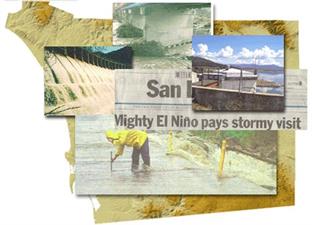Oceanside, CA - Fire
Home Fire MenuFlooding
Flooding Facts
Winter storms or rainy season in California can be deadly, causing flooding, flash floods, high coastal surf, mudslides, snow storms, and avalanches. Southern California does not have a high annual rain fall and often experiences long drought seasons. This fact may make us believe that we are safe and not subject to flooding hazards.
Oceanside, due to its location, is exposed and vulnerable to flooding, particularly during the winter rainy season.
Heavy rains can cause mud slide on the slopes and flooding in low lying areas surrounding the San Luis Rey River, Pilgrim Creek, Garrison Creek, Buena Vista Creek, and Loma Alta Creek. Storm systems such as a "Pineapple Express," or El Niño paired with extreme high tides, can bring storm surge into tidal bays and creeks. Tsunamis and hurricanes, which create huge waves, pose further risk to coastal areas. As the tsunami wave barrels into the shore, its strong currents can cause immense damage to buildings along the coast and in low-lying areas near the creeks.
Changing weather patterns, erosion, and development can affect floodplain boundaries. View the FEMA Flood Insurance Rate Maps (FIRMS). These digital flood hazard maps provide an official depiction of flood hazards for each community and for properties located within it.
Contact the City to find out the flood zone and level of risks in the area you live. FEMA conducts a Flood Insurance Study and uses the data to create FIRMs that show different flood risk areas. See your map and learn how to read it so you can make an informed decision about protecting your family, home, and business from hazard and losses from flooding. Prepare an emergency plan for your family.
All structures located in Special Flood Hazard Areas (SFHA), as designated on the Flood Insurance Rate Maps (FIRMs), are particularly vulnerable to flood hazards. Copies of FIRMs are available in the City Engineer's Office or on the City Webpage.
In the event of a potential significant storm, the City of Oceanside may utilize its Reverse-911 system (Alert San Diego) and phone calls would be made to residents and businesses with emergency information. Phone calls are made to landlines or to cell phone numbers that are registered with Alert San Diego. Cell phones may be registered free of charge; register your cell phone. There is no need to register landlines, for they are automatically in the Alert San Diego system.
 Before the Storm
Before the Storm
- Monitor TV and radio (for flood warnings KOGO 600 AM or KLSD 1360 AM).
- Know how to shut off electricity at the fuse panel and gas service at the meter.
- Never turn your gas service back on after shutting it off. Only a certified gas company representative should turn gas back on.
- Keep insurance documents and valuables in a safe-deposit box or move them to upper floors.
During and After the Storm
- Don't go near, swim, or drive through flood waters, and avoid downed power lines and broken gas lines.
- Follow local instructions regarding the safety of drinking water.
Flooding Preparedness
Flood protection can involve a variety of changes to your house and property – changes that can vary in complexity and cost. You may be able to make some types of changes yourself. Property protection measures include:
- Raise your furnace, water heater, and electric panel to higher floors or the attic if they are in areas of your home that may be flooded. Raising this equipment will prevent damage. An undamaged water heater may be your best source of fresh water after a flood.
- Install check valves in plumbing to prevent floodwater from backing up into the drains of your home. As a last resort, when floods threaten, use large corks or stoppers to plug showers, tubs, or basins.
- Seal walls in basements with waterproofing compounds to avoid seepage through cracks.
- Keep insurance policies, documents, and other valuables in a safe-deposit box.
- Move furniture and any other valuables to higher floors.
- If flooding is expected, consider using sand bags to keep water away from your home. Keep materials like sandbags, plywood, plastic sheeting, and lumber handy for emergency waterproofing.
- Keep watercourses free of fill/debris. Many people fail to recognize how regrading their yard, filling a wetland, or discarding leaves or branches in a watercourse can cause a problem to themselves and others.
- Do not dump or throw anything in to ditches and streams. No Dumping signs are posted on all inlets in the City. It is illegal and violation of City Ordinance No 40.1.2 to trash, grass clippings, tree branches, paint, grease or any other material in to any drainage system. Such dumping can plug the drains or channels, cause flooding and have devastating impact on water quality.
- Report to the City any illegal building, grading, and trash dumping. Make sure to always check with the City before you build on, alter, or place any fill in your property.





